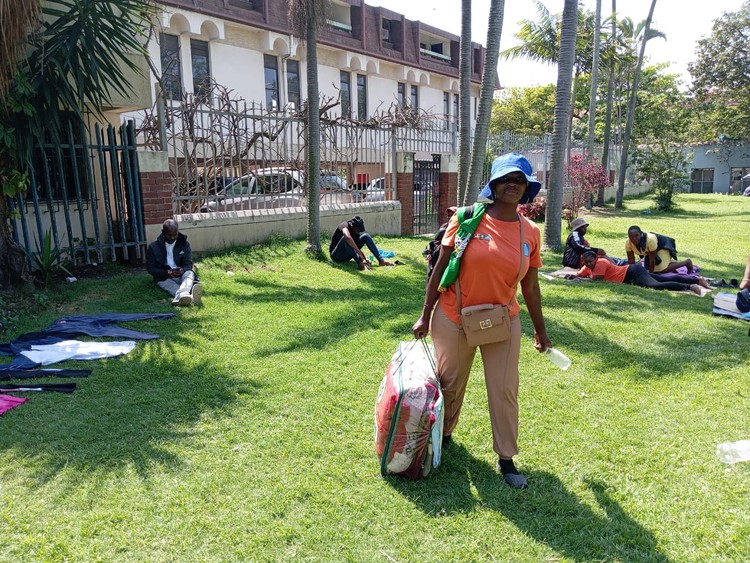Public uproar over the lack of information shared, running up to the last consultation process in February, forced the National Nuclear Regulator (NNR) to schedule another round of hearings. These crucial sessions began on Monday, 3 June, and will continue until Saturday, 8 June 2024. The NNR conceded that the public required more information but this only came after civil society organisations – including The Southern African Faith Communities’ Environment Institute (SAFCEI), Project90 by 2030, Save Bantamsklip, the Koeberg Alert Alliance (KAA), and Earthlife Africa Johannesburg– voiced their dissatisfaction with the overall governance and public participation process for the Koeberg lifetime operation (LTO) extension. SAFCEI, Save Bantamsklip and Project90 by 2030 have had to resort to the Promotion of Access to Information Act (PAIA) in order to access essential safety information.
SAFCEI’s Executive Director Francesca de Gasparis says, “One of the main issues is that the NNR put the cart before the horse by holding public hearings before the release of essential documentation, including for example the latest seismic risk study. Issues of safety are integral to determining the safety of the LTO. The last scientific study to assess seismic risk was done in 1976. The public needs to have sufficient data and time to make meaningful submissions. The safety of the LTO is a compliance and governance issue, and not one that we take lightly. Why are we being asked as South Africans to accept 20 more years of a nuclear power station that would get 10 years at most if it was in France, and crucially if it was deemed to be safe?”
At the core of civil society’s discontent with the consultation process is that a number of safety recommendations made by the International Atomic Energy Agency (IAEA) when it conducted a Safety Aspects of Long-Term Operations (SALTO) review in March 2022, have not been implemented. Up to now, Eskom has managed to do refurbishment work on the steam generators on both reactors in Unit 1 and Unit 2, but only Unit 1 is synchronized to the grid. Revision 3 of the Safety Case states that the remedial action will be taken during and after the LTO, but no specific dates were provided.
The IAEA recommended a complete revalidation of the qualification of cables in the containment building, for the long-term operation period. The agency also requires the full functionality of the containment structure’s monitoring system. Furthermore, the IAEA recommends the revalidation of time-limited aging analyses and aging management of the structures, systems and components. Failure to provide confirmation that these issues have been duly addressed has left no room for meaningful engagement. The containment structures storing high level waste are still cracked – one of which was a 110-metre crack back in 2022 – and aging management plans have not been shared with the public.
The IAEA’s concerns were corroborated by an emergency compliance drill conducted at Koeberg in November 2022, whose outcomes revealed 22 non-compliance issues among which is that the Mass Care Centre at the plant is not suitable to accept and respond to accident victims exposed to radioactive areas. The drill also revealed that decontamination showers were only suitable for chemical decontamination and not for radioactive decontamination, while emergency workers remain in radioactive areas for too long without protective face gear. This poses big health risks, not only to the workforce at Koeberg, but also to the members of the community in which they live; more especially the people they go home to and interact with after a day of exposure to radioactive material.
Koeberg Alert Alliance’s Lydia Petersen says, “Eskom has not been forthcoming about how it has addressed the critical safety issues, highlighted by the IAEA, regarding the LTO. Petersen says, “The secrecy by the NNR and Eskom around the LTO and the flawed execution of the public participation process are worrying for the protection of public interest with regard to the lifetime extension of Koeberg. At first, they did not want to make a safety case report available, then they released a heavily redacted version. After much pressure, the safety case is now available, but the 289 supporting documents are unavailable to the public. Why the secrecy?”
Director at Earthlife Africa Makoma Lekalakala says, “Extending Koeberg’s lifespan by another 40 years, also means more toxic waste. This means that waste disposal facilities need to be expanded, both on-site – where high-level radioactive waste is stored – and also at Vaalputs in Northern Cape – which stores low-level waste materials. There are no feasibility studies provided to support that such expansions are doable, especially when considering the proximity to local communities. If the population has grown, and chances are it has, then their safety must be a serious consideration. The conditions of the infrastructure to extend the life of the plant, in addition to the environmental and climate impacts, all affect the people and the planet.”
According to Gabriel Klaasen from Project90, “Koeberg is already temporarily storing 40 years’ worth of high-level radioactive nuclear waste, which remains highly toxic for thousands of years and for which there is no permanent solution. Once a week a truck containing low level nuclear waste travels along the R355, a road which is also used by other motorists and which is not up to international standards for moving nuclear waste. Over the years, four trucks have already had accidents on this very road and no interventions to either stop this mode of transporting nuclear waste or upgrading the road have been made, despite petitions by nearby communities. If we don’t have a solution for the existing waste, why would we extend Koeberg and add an additional 20 years of waste to the mess for future generations to deal with.”
“Not only is it unclear if the plant is safe, but we are being asked to accept that Koeberg is fit to go on for another twenty years when there is so much risk involved. The concerns raised need to be taken seriously for the safety of the environment and the people living in the areas around Koeberg. If Eskom has already addressed these issues sufficiently, where is the proof?” adds de Gasparis.
The post “NNR PUBLIC PARTICIPATION PROCESS IS A GOVERNANCE AND COMPLIANCE ISSUE, NOT TO BE TAKEN LIGHTLY” – CIVIL SOCIETY first appeared on SAFCEI.





